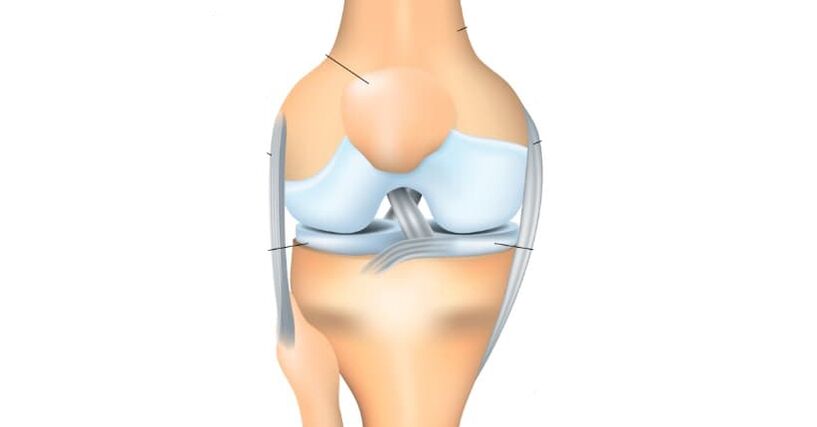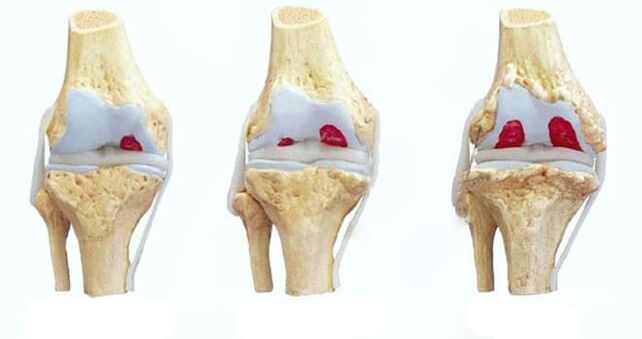A disease of non-infectious origin, in which, first of all, the hyaline cartilage of the knee joint suffers, which eventually collapses and ceases to perform its function, which leads to further damage to other components of the joint and damage to the joint. deformation.
This degenerative-dystrophic disease usually appears in women after the age of 40, but men can also suffer, especially those who are overweight, prone to frequent hypothermia, active in sports or due to injury.
Among all arthrosis, gonarthrosis of the knee joint is the most common.
There is an opinion that the cause of gonarthrosis is the deposition of salts in the joint. This opinion is completely wrong, and the deposition of salts is more of a secondary process and causes pain during the development of the disease and is localized at the attachment points of tendons and ligaments. Prevention plays an important role in disease prevention.
Anatomy of the knee joint

The knee joint consists of two surfaces, formed by the tibia and the femur. From the front, the knee joint protects the patella, which moves between the condyles of the femur. The fibula does not participate in the formation of the knee joint and does not carry any functional load, so it is often used to reconstruct other bone elements of the body.
All joint surfaces: the inner surface of the tibia, femur and patella are lined with hyaline cartilage, which has a very smooth structure, high strength and elasticity, the thickness of this dense and flexible structure reaches 5-6 mm. Cartilage absorbs cushioning during physical activity, prevents friction and softens impacts.
Classification of gonarthrosis
In terms of origin, gonarthrosis can be divided into primary manifestation, which occurs without injury, and secondary development, which is triggered by trauma, disease or developmental pathology, and is often unilateral. In this case, the first type of gonarthrosis usually occurs in elderly people and is rarely unilateral.
During its development, arthrosis of the knee joint goes through the following stages:
- The first stage of gonarthrosis- it does not cause significant suffering to the patient, it is characterized by occasional aching or squeezing pain, especially after strong physical exertion or direct strain on the knee joint. The symptom of so-called "initial pain" appears when the patient suddenly gets up, painful sensations appear, which gradually disappear, but if the limb is subjected to increased load, the pain reappears. A slight swelling may occur, which goes away on its own. Rarely, but it happens, joint paininflammation - fluid accumulates in the joint bag of the knee, due to which the knee area becomes round and swollen, the movement of the limbs is limited. At this stage, there is no deformation of the joint.
- Second stage- the patient begins to be bothered by long-lasting and rather strong pains on the front and inner side of the joint, even with a light load, but these usually disappear after a long rest. When the joint moves, a crack is heard, if the patient tries to bend the limb as much as possible, a sharp pain occurs. The amplitude of the movement of the joint is limited and the deformation begins to be detected. Synovitis occurs often, bothers you for a long time, and is associated with the accumulation of a large amount of fluid in the joint.
- Third stage- it causes significant suffering to the patient, the pain is constant and not only when walking, but also when resting, and even at night, it disturbs and prevents sleep. The joint is already significantly deformed, the position of the limb will be X or O shaped. A waddling gait appears, and often due to a significant deformation, the person cannot not only bend, but also fully extend their legs, as a result of which they have to walk with a cane or even crutches.
Pathology of gonarthrosis of the knee joint

- In the initial, first stage of gonarthrosis, due to the development of a pathological process in the vessels supplying the intraosseous hyaline cartilage, the joint surfaces gradually lose their characteristic properties. They begin to dry out, lose their smooth texture, cracks appear, due to which the sliding of the joint surfaces is disturbed, they begin to stick together, increasing surface defects. Hyaline cartilage degenerates and loses its shock-absorbing function due to constant microtraumas.
- In the second stage of gonarthrosis, the degenerative-dystrophic manifestations increase: the joint space narrows, the joint surfaces flatten, adapting to the increasing loads. The part of the bone adjacent to the hyaline cartilage of the joint becomes denser, and along its edges bone tissue appears, similar to spikes. The capsule of the knee joint also changes and loses its flexibility. The fluid inside the joint becomes thicker and more viscous, changing its nutritional and lubricating properties, further impairing joint function. Due to malnutrition, the condition of the hyaline cartilage continues to deteriorate, it begins to decay, and in some places it disappears completely. As a result of the increased friction, the degeneration of the knee joint gradually increases, which leads to the third stage of gonarthrosis.
- In the third stage of gonarthrosis, there is a marked limitation of the range of motion of the joint. The surfaces are significantly deformed, the hyaline cartilage is practically absent, the bones seem to be pressed into each other.
Causes of gonarthrosis
In essence, it is impossible to determine a single cause of gonarthrosis. Basically, it is the result of many causes and many internal and external factors.
In 20-30% of cases, gonarthrosis is caused by traumatic injuries of the knee joints or their components (ligaments, tendons, menisci), as well as fractures of the femur or tibia. The disease usually appears 3-5 years after the injury. But in the early period (2-3 months) there were cases of gonarthrosis.
In some patients, gonarthrosis is triggered by heavy physical exertion. Active physical activity can often provoke illness, especially after the age of 40, when people begin to exercise actively to maintain health and recognize the need for a healthy lifestyle. Running, jumping and squatting put the most stress on the joints.
Being overweight can also cause gonarthrosis, especially with varicose veins of the lower limbs. The load on the knee joints increases, and microtraumas or even serious injuries occur in the menisci or ligaments of the joint. In this case, recovery is much more difficult because. it is impossible to quickly lose excess weight in order to relieve the load on the joint.
Different types of arthritis (gouty, psoriatic, rheumatic, reactive or Bechterew's disease), certain neurological diseases (spinal injuries, craniocerebral injuries and other diseases involving damage to the innervation of the lower limbs), and hereditary diseases. provokes the development of gonarthrosis. causing connective tissue weakness.
Diagnosis of gonarthrosis
In order to diagnose a patient with gonarthrosis, a combination of collecting complaints, examination and X-rays is necessary.
Nowadays, the X-ray of the joint is the simplest and most accessible research method, with the help of which the patient can be diagnosed with sufficient accuracy, and the dynamic evolution of the process can be observed and determined. tactics of further treatment. Among other things, the X-ray enables a differential diagnosis to be made, for example, in the bone tissue of the thigh or lower leg, or to rule out an inflammatory tumor process. Computed tomography and magnetic resonance imaging are also used to diagnose gonarthrosis, which can show changes not only in bone structures, but also in soft tissues.
In old age, everyone has certain symptoms of gonarthrosis, so the diagnosis can only be made after a complete collection of anamnestic data, complaints and visual examination, as well as instrumental research methods.
Treatment of gonarthrosis of the knee joint
When the first signs of knee joint disease appear, you should consult an orthopedic doctor as soon as possible. At the initial stage of the process, the doctor prescribes drug therapy and complete rest of the affected limb.
After the acute period ends, it is possible to make the following appointment:
- exercise therapy course,
- massage,
- and physiotherapy procedures (electrophoresis with painkillers, UHF therapy, magnetic or laser therapy, phonophoresis with anti-inflammatory steroids, mud treatment, etc. )
In the next stage of treatment, the doctor may prescribe drug therapy, which includes taking chondroprotectors that stimulate joint metabolic processes. Sometimes intra-articular injections with hormone-containing drugs are required. If the patient has the possibility of sanatorium-bath treatment, then this is recommended. It is often recommended to the patient to use a cane while walking to relieve the joint. For prevention, you can use special orthopedic insoles or orthoses.
If the patient is diagnosed with the third stage of gonarthrosis, in which its manifestations are the most pronounced (pain, impaired function of the joint or its complete absence), surgical treatment may be required, consisting of knee arthroplasty. Rehabilitation measures usually last 3-6 months until joint function is completely restored, after which the patient can return to normal life.
Prevention
In order to avoid age-related degenerative-destructive changes in the knee joint, it is necessary for physical education, wearing orthopedic shoes, weight control, and observing the rest and training schedule.



















